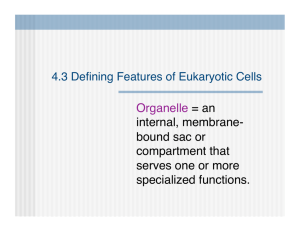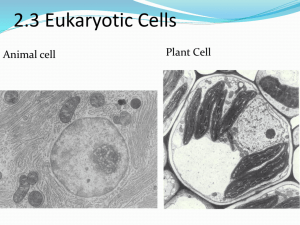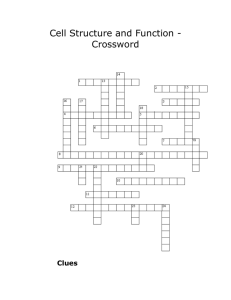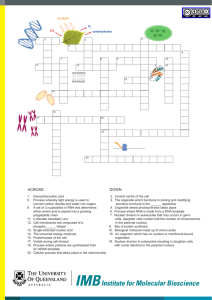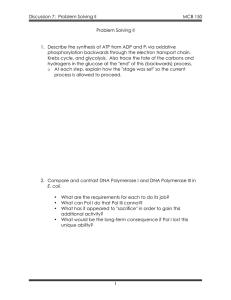Problem Solving III
advertisement
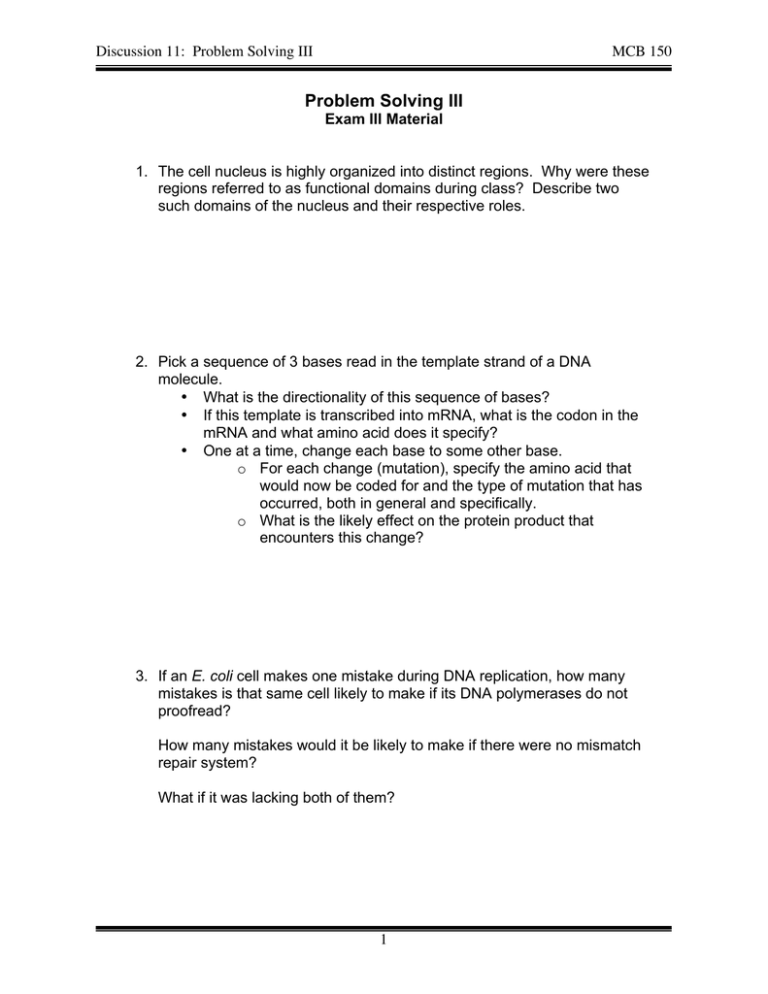
Discussion 11: Problem Solving III MCB 150 Problem Solving III Exam III Material 1. The cell nucleus is highly organized into distinct regions. Why were these regions referred to as functional domains during class? Describe two such domains of the nucleus and their respective roles. 2. Pick a sequence of 3 bases read in the template strand of a DNA molecule. • What is the directionality of this sequence of bases? • If this template is transcribed into mRNA, what is the codon in the mRNA and what amino acid does it specify? • One at a time, change each base to some other base. o For each change (mutation), specify the amino acid that would now be coded for and the type of mutation that has occurred, both in general and specifically. o What is the likely effect on the protein product that encounters this change? 3. If an E. coli cell makes one mistake during DNA replication, how many mistakes is that same cell likely to make if its DNA polymerases do not proofread? How many mistakes would it be likely to make if there were no mismatch repair system? What if it was lacking both of them? 1 Discussion 11: Problem Solving III MCB 150 4. Why are errors in transcription: • more frequent than errors in DNA replication? • less critical than errors in DNA replication? 5. Why is the semi-permeability of phospholipid bilayers essential for lysosomal function? 6. Protein P was recently characterized as an exclusively nuclear protein. It is a large protein of 120 kDa that does not have a nuclear localization signal. Propose a mechanism by which protein P is recruited to the nucleus. Draw a schematic representation of your proposed pathway and indicate the source of energy if one is needed. 2 Discussion 11: Problem Solving III MCB 150 7. Protein P (from the previous question) was shown to have a nuclear export signal and an RNA binding domain. Propose a role for protein P. How could you reconcile the fact that protein P has an NES but is only detected in the nucleus? 8. Cells can internalize foreign material by phagocytosis. However, when the foreign material cannot be degraded, like asbestos fibers (a material that was once used extensively for the insulation of buildings), it accumulates in one type of organelle within the cell cytoplasm. Which one? Explain why. 9. In the intestinal track of mammals, specialized epithelial cells secrete large quantities of digestive enzymes. Which organelle(s) would you expect to be very prominent in these cells? Justify your hypothesis. 3 Discussion 11: Problem Solving III MCB 150 10. Secreted proteins are usually about 20 amino acids longer when they are synthesized by free ribosomes in a test tube (RER is absent from the test tube) than when synthesized in vivo. Yet, free ribosomes function identically to membrane-bound ribosomes. What hypothesis can you propose to explain this experimental observation? 11. Let’s consider a trans-membrane protein, TMP, destined to the plasma membrane. Suppose that you could link a fluorescent dye to the cytoplasmic domain of a few TMP molecules still associated with the rough ER. You then follow the fate of the labeled TMPs using fluorescence microscopy. As the labeled TMPs distribute among cellular compartments, where would you expect the dye to be located? Draw a schematic representation of your answer, in which you should indicate which side(s) of the cellular compartments (cytoplasm vs. lumen/outside of the cell) are labeled. 4

